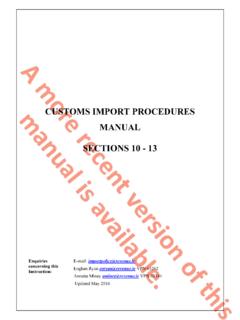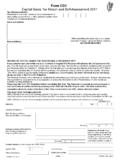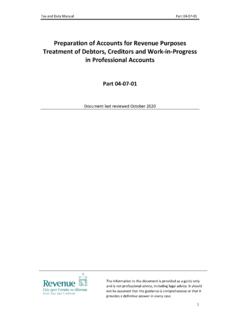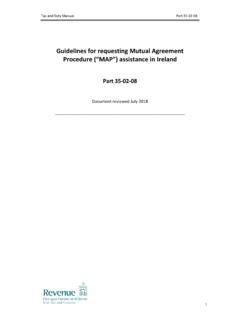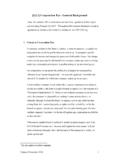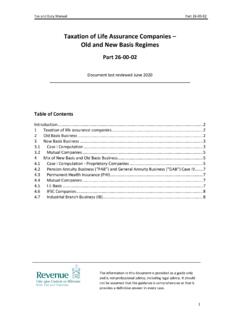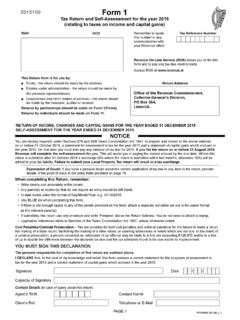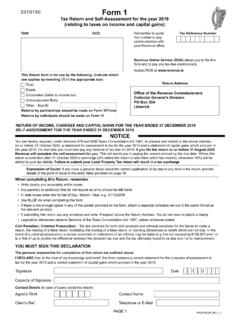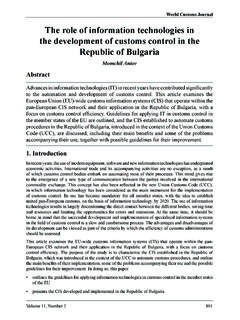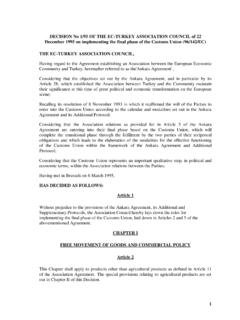Transcription of End-use guidelines for traders - Revenue
1 June 2018 End-use guidelines FOR traders 2 1. INTRODUCTION .. 4 What is End-use ? .. 4 How does End-use work? .. 4 EU legislation .. 4 What goods qualify for End-use relief? .. 4 Who can apply for End-use relief ? .. 6 Exclusions from relief .. 6 2 AUTHORISATION .. 6 Types of End-use authorisations .. 6 Issue of an 7 Application for an authorisation based on a customs declaration (simplified authorisation) .. 8 Retrospective 9 Guarantee .. 10 Validity .. 11 3 ENTRY OF GOODS TO End-use .. 12 Movement of goods under End-use .. 12 TORO (Transfer of Rights and Obligations) .. 13 4. OBLIGATIONS OF AUTHORISATION HOLDERS.
2 14 Revenue supervision .. 14 Time limits .. 14 Period of discharge .. 14 15 Bill of discharge .. 15 Control measures .. 16 Satisfying End-use conditions .. 16 Waste and scrap .. 17 5. Storage of goods .. 18 3 6. Cases where the End-use procedure is not necessary .. 18 APPENDIX I - General conditions to be observed by persons authorised to engage in an End-use Arrangement.. 19 APPENDIX II - Conditions to be observed by persons authorised to operate equivalence .. 22 4 1. INTRODUCTION What is End-use ? End-use is a Customs procedure whereby goods entered for free circulation in the European Union (EU) may be given favourable tariff treatment or relief at a reduced or zero rate of duty on condition they are put to a prescribed use.
3 How does End-use work? In order to obtain End-use relief, the importer must be the holder of an authorisation. The goods must be put to a prescribed use within a certain period of time. The importer must also keep records on the goods and their treatment. If the goods are not put to the prescribed End-use , duty will be due. The relief applies to customs duty only and does not extend to any Anti-Dumping Duty, Value-Added Tax or Excise Duty that may be payable. There is an exception in the case of the admission of goods into territorial waters in connection with drilling or production platforms. In this case an authorisation for the End-use procedure also allows the suspension of Value-Added Tax.
4 This is provided for in Regulation 14(4) of the Value-Added Tax Regulation 2010 ( 639/2010). EU legislation The legal basis for the End-use regime is set out in: Council Regulation (EC) No. 952/2013 (Union Customs Code) Commission Regulation (EC) No. 2015/2447 (Implementing Regulation) Commission Regulation (EC) No. 2015/2446 (Delegated Regulation). What goods qualify for End-use relief? Goods eligible for End-use identified by their tariff classification There is provision in the Tariff for suspension of duties on certain goods. The suspension of the duties is dependent on the End-use of the goods. 5 For example, the following regulations make the granting of the suspensive rate subject to End-use control: o Council Regulation (EU) No 1344/2011 of 19 December 2011 - suspending the autonomous Common Customs Tariff o Council Regulation (EU) No 3050/95 of 22 December 1995 - temporarily suspending the autonomous Common Customs Tariff duties on a number of products intended for the construction, maintenance and repair of aircraft.
5 Products intended for aircraft, ships, boats and for drilling platforms as set out in Part I, Section II of the Combined Nomenclature A listing of tariff headings or codes for these products is given each year in the Combined Nomenclature. Weapons and military equipment certified by a competent authority Provision is made under Council Regulation No. 150/2003 to suspend import duties on a number of military weapons and equipment on condition that the goods are being used by, or on behalf of, the military forces of a Member State for: o the defence of the Member State o international peacekeeping or o support operations. Duty is suspended for importation of goods under this regulation subject to the application of End-use controls and the issue of the appropriate certificate by the competent authority.
6 In Ireland the competent authority is the Department of Defence. Businesses importing such goods on behalf of the Department of Defence must: o be authorised for End-use , and o hold the appropriate certificate issued by that Department (or by the equivalent competent authority in another Member State) covering the goods they wish to import. 6 Appendix III contains a list of 4-digit Tariff headings covering weapons and military equipment on which import duties are suspended. Who can apply for End-use relief ? The applicant must be established in the EU. Those who may qualify include: importers who themselves put the goods to the prescribed End-use importers who partly process the End-use goods and then transfer the partly processed goods to other persons or traders authorised to carry on the End-use process or importers of End-use goods who themselves do not carry out any End-use processing but merely distribute the goods to other authorised persons who then put the goods to the prescribed End-use .
7 Exclusions from relief Goods NOT in Free Circulation are excluded from relief. The provisions of this guide do not apply to goods on entry to another customs procedure, such as inward processing or warehousing. However, when these goods are eventually placed in free circulation End-use relief may be claimed. 2 AUTHORISATION You must be authorised to use the End-use procedure. Types of End-use authorisations There are three main types of End-use authorisation: An authorisation covering one Member State which allows the holder to avail of End-use in Ireland only. An authorisation covering more than one Member State - this type of authorisation will allow the trader to benefit from the End-use provisions in more than one Member State.
8 An application for such an authorisation is generally submitted in the 7 Member State where the applicant s main accounts are held. A company whose main accounts are held in Ireland should apply to Revenue to have another Member State or states included in their Irish authorisation. In the same way a company whose accounts are held in another Member State should apply to the customs authorities in the other Member State to have Ireland included in their authorisation. An application for an authorisation based on a customs declaration (simplified authorisation). This type of authorisation is suitable for once-off importations. Applications for simplified authorisations are dealt with by the Revenue official at the point of importation.
9 All other applications for authorisations to import goods under End-use should be made by using the EU Customs Decision System on the Revenue website. Issue of an authorisation Before an authorisation can be granted the following conditions must be met: Applicants must be able to satisfy Revenue that: o they are in a position to operate the End-use regime correctly (including, where applicable, the provisions for the transfer of goods) o the prescribed End-use can be complied with, and o the regime will not be abused to avoid payment of duty. Applicants must undertake to assign the goods to the prescribed End-use or to transfer them to another operator and to provide the required evidence of their assignment or transfer.
10 Revenue supervision of the goods must be assured. Any administrative burden must not outweigh the economic benefits of the relief. The applicant must maintain adequate and auditable records. The applicant must submit a bill of discharge. 8 A guarantee must be provided. Applicants must undertake to notify Revenue of any change of circumstances or other factors, which may affect the authorisation. A set of conditions relating to the use of the authorisation will have to be signed by the Secretary or Managing Director in the case of a limited company, or by the owner or partner in the case of other traders (see Appendix 1). Application for an authorisation based on a customs declaration (simplified authorisation) You can apply for a simplified authorisation where eligible goods are being imported for a particular End-use : on a one-off basis, for example to facilitate those who are not regular importers, or where the importation is a straightforward operation and the nature of the intended End-use is simple and the Revenue supervision required is uncomplicated.

